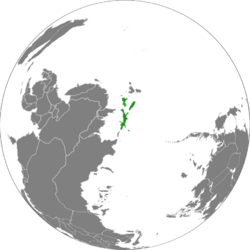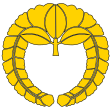Mitoyagi Empire
| Mitoyagi Empire 大水戸矢木帝国 Dai Mitoyagi Teikoku | ||||||
| ||||||
| ||||||
| Motto Unitas Et Aequalitas "団結と平等" "Unity and Equality" | ||||||
| Anthem Sankokuren (official) | ||||||
Territory of Okaiken in 1947, prior to Great Adonian War
| ||||||
| Capital | Okashi | |||||
| Languages | Official language: Sanese Unofficial minority languages: Kwangju | |||||
| Religion | Shinto~50% Baiduism~50% | |||||
| Government | Constitutional monarchy | |||||
| Emperor | ||||||
| - | 1871–1908 | Saito | ||||
| - | 1908-1937 | Go-Shōkō | ||||
| - | 1937–1968 | Wakayama | ||||
| Prime Minister | ||||||
| - | 1872–1875 | Juichi Miyazaki (first) | ||||
| - | 1968-1970 | Yoshimizu Ohno (last) | ||||
| Legislature | Diet | |||||
| - | Lower House | House of Officers | ||||
| - | Lower house | House of Commoners | ||||
| Historical era | Saito Era Go-Shōkō Era Wakayama Era | |||||
| - | Saito Restoration | January 3, 1871 | ||||
| - | Quiet Revolution | June 6, 1968 | ||||
| - | Official Transition into Republic | 1 January 1970 | ||||
| Area | ||||||
| - | 1940 | 180,466.74 km² (69,679 sq mi) | ||||
| Population | ||||||
| - | 1871 est. | 9,225,469 | ||||
| - | 1890 est. | 12,325,187 | ||||
| - | 1940 est. | 22,275,156 | ||||
| Density | 123.4 /km² (319.7 /sq mi) | |||||
| - | 1968 est. | 32,693,447 | ||||
| Currency | Sanese En | |||||
| Today part of | ||||||
| Area and population not including colonial possessions | ||||||
The Mitoyagi Empire (大水戸矢木帝國 Dai Mitoyagi Teikoku, literally "Great Mitoyagi Empire") was an empire and world power that existed from the Saito Restoration on January 1871 to the Quiet Revolution in 1968. Mitoyagi's rapid industrialization and militarization under the slogan Fukoku Kyōhei (富国強兵 "Enrich the Country, Strengthen the Army") led to its emergence as a world power, eventually culminating in its partnership with Bruellen and Trentannia and the conquest of a large part of the Eastern Althenian region. At the height of its power in 1950, the Empire of Mitoyagi ruled over a land area spanning 7,400,000 square kilometres (2,857,000 sq mi), making it one of the largest maritime empires in history.
After several large-scale military successes during the Great Adonian War, the Empire of Mitoyagi also gained notoriety for its war crimes against the peoples of the countries it conquered. After suffering many defeats, however, the Empire of Mitoyagi surrendered to the Allies on 1952. A period of occupation by the Allies followed the surrender, but it kept the old system due to volatility during the occupation. Allied occupation and Sanese reconstruction of the country continued well into the 1950s, until severe economic downturns in the 1960s culminated in protests now known as Quiet Revolution. These events eventually formed Okaiken in 1968.
The Emperors during this time, which spanned the entire Saito, Go-Shōkō, Wakayama and the lesser part of the Jutsu era, are now known in Okaiken by their posthumous names, which coincide with those era names: Emperor Saito(Hirohito), Emperor Go-Shōkō (Yoshihito), and Emperor Wakayama (Mutsohito). Emperor Masahito (Jutsu) was reinstated as Emperor in 2011.
Terminology[edit | edit source]
Although the empire is frequently referred to as "the Sanese Empire" or "Imperial Mitoyagi" in Trentannian, the literal translation from kanji is Great Imperial State of Mitoyagi (Dai Mitoyagi Teikoku):
- Dai "Great"
- Mitoyagi "Mitoyagi"
- Tei "Imperial"
- -koku "State" or "Nation"
This meaning is significant in terms of geography, encompassing the Mitoyagi Islands and its surrounding areas. The nomenclature Empire of Mitoyagi had existed since the anti-Honda domains, Satsuma and Chōshū, which founded their new government during the Saito Restoration, with the intention of forming a modern state to resist western domination.
History[edit | edit source]
| ||||||||||||||||||||||||||||||||||||||||||||||||||||||||



